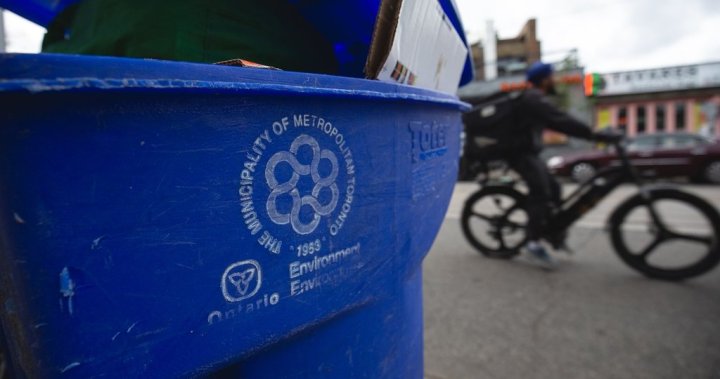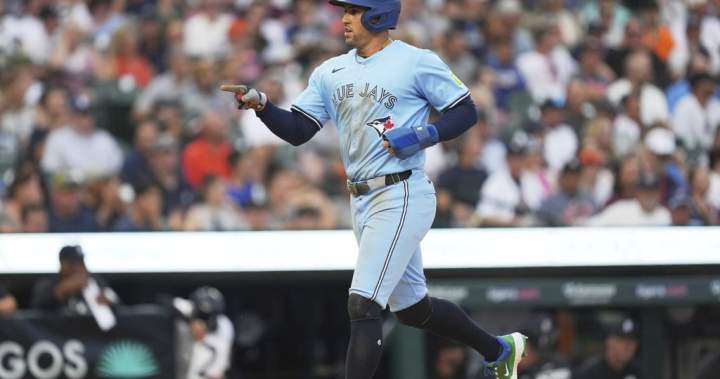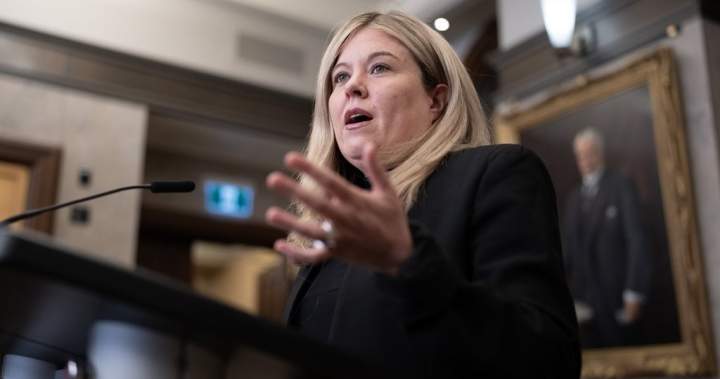Uncategorized
Ontario proposes to weaken impending new recycling rules over costs to producers

Ontario Premier Doug Ford’s government is proposing to weaken an impending slate of new recycling rules because producers of the materials said the system is getting too expensive.
The province began transitioning in 2023 toward making producers pay for the recycling of their packaging, paper and single-use items. The companies’ obligations were set to increase next year, but the government is now looking to delay some measures and outright cancel others, such as requirements to extend collection beyond the residential system.
Environmental advocates say the proposed changes let producers off the hook and will mean more materials will end up in landfills or be incinerated. Producers say despite the rising costs, recycling rates don’t actually appear to be improving, so it’s time for a broader rethink.
Environment Minister Todd McCarthy said the proposed changes are about ensuring the sustainability of the blue box system and protecting against unintended consequences such as job losses.
“We want to take what we’ve done and improve upon what already exists, but the costs were a big deal, and so we’re proposing some measures that would bring about cost savings and transparency and improvement to accomplish the goal of recycling that we all want,” he said earlier this month.
The Canadian Retail Council estimates that producer costs have already increased by about 350 per cent in three years and would nearly double again just from this year to next if no changes were made to the impending new rules for 2026.
The government says blue box collection costs could more than double between 2020 and 2030.
“Cost increases of this magnitude were not anticipated when the regulation was passed in 2021 and have jeopardized the stability of the blue box system today,” it says in its proposal to change the rules.
Currently, producers just have to make “best efforts” to hit certain recycling rate percentages, such as 80 per cent of paper and 50 per cent of rigid plastic, and starting next year they are set to be enforceable. Then in 2030 those percentages are set to rise.

Get breaking National news
For news impacting Canada and around the world, sign up for breaking news alerts delivered directly to you when they happen.
But now the government is proposing to delay those 2026 targets to 2031.
As well, Ontario is proposing to allow non-recyclable material that gets incinerated to count for up to 15 per cent of producers’ recycling targets.
Starting next year, producers are also supposed to be responsible for collecting material from more multi-residential buildings, and certain long-term care homes, retirement homes and schools. The government is now proposing to remove that requirement entirely.
The same goes for a rule that would have made beverage producers responsible for containers not just dropped in a residential blue box but also those used outside the home, and a provision for producers to expand collection in public spaces.
The intent behind the initial regulations was to incentivize producers to use less packaging and to use materials that can more easily be recycled, said Karen Wirsig, senior program manager for plastics with Environmental Defence.
These changes would halt any progress on that score, she said.
“Municipalities have been saying for years, ‘Our blue box is getting more and more filled with packaging types we can’t even identify let alone properly sort … because often they’re made with mixed materials that are not easily recycled,’” Wirsig said.
“So because there was that disconnect between the producers who design all this packaging and the municipalities who are collecting it, there was no way to rationalize the system and improve packaging from an environmental and sustainability point of view. These regulations were intended to start doing that, and unfortunately, now all of the incentives are going the opposite direction.”
The recycling of flexible plastics, which includes food wraps, pouches and bags, is a particular bone of contention and the government is proposing to both delay and reduce the target for that category.
In a recycling facility, flexible plastics end up in all sorts of places because they’re so light, getting stuck among paper or falling through the cracks of conveyor belts, said Michael Zabaneh, the Retail Council of Canada’s vice-president of sustainability.
Instead of a recycling target of 25 per cent taking effect next year, a target of five per cent would take effect in 2031 under the government’s proposal for flexible plastics.
That five per cent reflects the estimated current level of flexible plastic diversion, according to the government’s regulatory proposal. It is silent on the current levels for all other materials.
Those current levels are unknown, with the Resource Productivity and Recovery Authority saying it will report on rates once the three-year transition is over. That is a big problem, said Zabaneh.
“We’re all in the blind,” he said. “I think you can’t have a recycling system with accountability, (and not have) transparency and real data.”
The main problem with the government’s current system is that it allows for multiple administrators, said Zabaneh. Producers sign up with producer responsibility organizations, which help them meet their blue box obligations.
There are four such organizations operating in Ontario, which just ends up complicating the system and making it more expensive, Zabaneh said.
“There’s an administrative body to drive collection, but then processing is kind of a competitive thing, and this creates a very fragmented and inefficient system,” he said.
“It limits planning, it prevents collective investment, capital investment, so that’s disincentivized, and you have a lot of added costs from logistics and audits, and that’s why we have escalating costs.”
Retail council members helped found and sit on the board of one producer responsibility organization so they have some idea of recycling rates from that, and based on that limited view the numbers look stagnant, the council says.
Producers welcome the delayed targets, Zabaneh said, but it doesn’t solve the core problem. Having a single producer responsibility organization would reduce costs and allow for greater transparency of recycling rates and financial performance, the retail council says.
Canadian Beverage Association president Krista Scaldwell said their members want the system to be successful because recycling and recovery benefits companies as well as the environment.
“We want the aluminum and plastic back because we can make it into new containers,” she said.
“The members are very committed to sustainability initiatives, and so we need to understand what’s creating the cost so that we can help support some change, so we can see improved recovery without escalating costs.”
Comments on the regulatory registry proposal can be submitted until July 21.
Uncategorized
Springer cleared to return, will rehab with Bisons

TORONTO – Blue Jays slugger George Springer has been cleared to return to game action after suffering a concussion over two weeks ago, Toronto manager John Schneider said Wednesday.
The 35-year-old outfielder/designated hitter hasn’t played since July 28 when he was hit in the helmet by a fastball thrown by Baltimore Orioles pitcher Kade Strowd.
Springer, who was on hand for batting practice before Toronto’s game against the Chicago Cubs on Wednesday night, was expected to play for the Triple-A Buffalo Bisons on Thursday.
Related Videos
“Play DH tomorrow and then see if he needs a game in the outfield to see how he feels,” Schneider said in his pre-game availability. “But he’ll be doing that tomorrow.”

Get breaking National news
For news impacting Canada and around the world, sign up for breaking news alerts delivered directly to you when they happen.
Springer has been one of the top offensive performers this season for the Blue Jays (70-50), who had a 4 1/2-game lead on the Boston Red Sox in the American League East standings entering play Wednesday.
Over 101 games, Springer has a .291 average, 18 homers, 57 RBIs and an on-base and slugging percentage of .889.
Strowd’s 96-m.p.h. pitch appeared to hit Springer’s shoulder before making contact with his helmet near the ear flap. After laying prone for a moment or two, Springer got up slowly and left the field with some assistance.
He was placed on the seven-day concussion injured list on July 29.
This report by The Canadian Press was first published Aug. 13, 2025.
© 2025 The Canadian Press
Uncategorized
Pair of shaggy Highland cattle making their debut at the Toronto Zoo – Toronto

Two delightfully shaggy new faces will be on display at the Toronto Zoo starting on Friday.
The nine-month-old brothers are Scottish Highland cattle, with long, woolly, reddish coats and fringe over their eyes.
The zoo’s manager of wildlife care, Marc Brandson, says the two were born and raised at a local Ontario farm before moving to the zoo about a month ago.
He says they completed a quarantine period and now live just outside the Eurasia Wilds area of the zoo.

Get daily National news
Get the day’s top news, political, economic, and current affairs headlines, delivered to your inbox once a day.
Membership holders can visit the brothers at a pre-screening on Thursday, while other visitors can see them starting Friday.
Brandson says there is “a lot of excitement” around the pair because of how popular the Highland breed already is.
He says the zoo is hoping to have the brothers walk through the public area of the zoo as part of its animal ambassador program, which can give visitors a closer look at certain animals.
“Each and every day, our outreach and discovery staff are working to get them to that level,” he said.
“Having a bonded pair is a really great social situation for Highland cows. These brothers are very calm and they are gaining confidence each and every day that they interact with their caregivers.”
The brothers don’t have names yet, and Brandson says the public should stay tuned on ways to contribute naming ideas.
© 2025 The Canadian Press
Uncategorized
Conservative MP calls on Ottawa to do more on wildfires, criticizes forest entry ban

Conservative MP Michelle Rempel Garner says the federal government needs to do more to fight Canada’s devastating forest fires.
Speaking to reporters Wednesday in Ottawa, the Alberta MP accused Ottawa of “inaction” on wildfires. She also blamed that lack of action for new measures restricting activities in the forests of two provinces — even though those bans were imposed by the provinces themselves.
Nova Scotia and New Brunswick last week banned hiking, fishing, camping and the use of vehicles in its forests in response to the heightened wildfire risk.
Rempel Garner said that while she understands the fear Maritimers feel, restricting individuals’ movements is “not right.”
“Whenever there’s a major crisis, what the Liberal government has done by their inaction has conditioned Canadians to expect that the only response they can see out of their federal government is to restrict their movement,” Rempel Garner told reporters.
“We’re calling on the federal government to actually get serious about this issue.”

Get daily National news
Get the day’s top news, political, economic, and current affairs headlines, delivered to your inbox once a day.
Conservative MP Marc Dalton presented a bill last year to stiffen penalties for wildfires caused by arson. It never made it past first reading and died when Parliament was dissolved ahead of this year’s election.
Rempel Garner said that’s one area where the Liberals could have taken action on wildfires. She also called on the federal government to dedicate more resources to wildfire control.
In its 2021 election platform, the Liberals promised to train 1,000 community-based firefighters to fight wildfires and to work with provinces and territories to get them more firefighting planes.
Last month, Ontario Premier Doug Ford told reporters that Alberta-based water bomber manufacturer De Havilland was facing a four-year backlog of orders.
“Four full wildfire seasons ago, the Liberals promised more water bombers, more firefighters,” Rempel Garner said. “Where are they?”
Nova Scotia Premier Tim Houston brushed off the criticisms of the forest entry ban at a press conference later Wednesday.
“I find it remarkable, the interest in travelling in Nova Scotia woods by people who aren’t in Nova Scotia and probably haven’t been here much in their life,” Houston told reporters.
“We’re only concerned with keeping people safe. We’ll do what’s necessary to protect lives, and that’s what we’re doing in this case.”
So far this season, the total area of the country burned by wildfires is nearly the size of the entire province of New Brunswick.
— With files from Sarah Ritchie.
© 2025 The Canadian Press
-

 Uncategorized2 months ago
Uncategorized2 months agoAccording to Dior Couture, this taboo fashion accessory is back
-

 Uncategorized2 months ago
Uncategorized2 months agoThese ’90s fashion trends are making a comeback in 2017
-

 Uncategorized2 months ago
Uncategorized2 months agoThe old and New Edition cast comes together to perform
-

 Uncategorized2 months ago
Uncategorized2 months agoUber and Lyft are finally available in all of New York State
-

 Uncategorized2 months ago
Uncategorized2 months agoNew Season 8 Walking Dead trailer flashes forward in time
-

 Uncategorized2 months ago
Uncategorized2 months agoMeet Superman’s grandfather in new trailer for Krypton
-

 Uncategorized2 months ago
Uncategorized2 months ago6 Stunning new co-working spaces around the globe
-

 Uncategorized2 months ago
Uncategorized2 months agoThe final 6 ‘Game of Thrones’ episodes might feel like a full season







